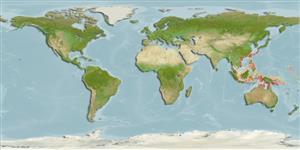Teleostei (teleosts) >
Gobiiformes (Gobies) >
Gobiidae (Gobies) > Gobiinae
Etymology: Istigobius: Greek, istios = sail + Latin, gobius = gudgeon (Ref. 45335).
Eponymy: Dr Douglas Houghton Campbell (1859–1953) was a botanist and a Professor at Stanford University. [...] (Ref. 128868), visit book page.
More on authors: Jordan & Snyder.
Environment: milieu / climate zone / depth range / distribution range
Ecology
Marine; demersal; depth range 3 - 14 m. Tropical; 30°N - 15°S
Northwest Pacific: southern Japan, Taiwan, and Hong Kong.
Length at first maturity / Size / Weight / Age
Maturity: Lm ?, range 2 - ? cm
Max length : 7.1 cm TL male/unsexed; (Ref. 420); 7.8 cm TL (female)
Dorsal spines (total): 7; Dorsal soft rays (total): 10 - 11; Anal spines: 1; Anal soft rays: 9 - 10; Vertebrae: 26. Upper pectoral fin rays entire. Predorsal cycloid scales 10-13; ctenoid on trunk. Body dusky brown with red spots; 4 blue spots on operculum; black line running from eye along sensory pore path to pectoral base; 2 dusky blotches on pectoral base, the uppermost spreading onto fin rays; large inverted `U'-shaped blotch on the cheek. In male, appressed anal fin occasionally reaching caudal fin, appressed dorsal reaching or overlapping caudal fin. Appressed anal and dorsal fins of female ending 2-3 and 1-2 scales, respectively, of caudal fin.
Common in sandy bottoms of shallow waters. Also observed to live solitarily or in small schools near crevices or under stones. Occurs at 21.5 °C (Ref. 4959).
Genital papilla of male terminating to side of anal spine, of female terminating well before origin of anal fin and sometimes it is slightly pigmented.
Murdy, E.O. and D.F. Hoese, 1985. Revision of the gobiid fish genus Istigobius. Indo-Pac. Fish. (4):41 p. (Ref. 420)
IUCN Red List Status (Ref. 130435: Version 2024-1)
Threat to humans
Harmless
Human uses
Tools
Special reports
Download XML
Internet sources
Estimates based on models
Preferred temperature (Ref.
123201): 24.3 - 28.1, mean 27.4 °C (based on 299 cells).
Phylogenetic diversity index (Ref.
82804): PD
50 = 0.5010 [Uniqueness, from 0.5 = low to 2.0 = high].
Bayesian length-weight: a=0.01023 (0.00477 - 0.02194), b=3.01 (2.83 - 3.19), in cm total length, based on LWR estimates for this (Sub)family-body shape (Ref.
93245).
Trophic level (Ref.
69278): 3.3 ±0.3 se; based on size and trophs of closest relatives
Resilience (Ref.
120179): High, minimum population doubling time less than 15 months (Preliminary K or Fecundity.).
Fishing Vulnerability (Ref.
59153): Low vulnerability (10 of 100).
Nutrients (Ref.
124155): Calcium = 455 [217, 1,141] mg/100g; Iron = 1.73 [0.93, 3.44] mg/100g; Protein = 17.6 [15.8, 19.2] %; Omega3 = 0.235 [0.094, 0.480] g/100g; Selenium = 30.1 [14.5, 66.1] μg/100g; VitaminA = 39.3 [10.9, 126.7] μg/100g; Zinc = 2.31 [1.53, 3.52] mg/100g (wet weight);
